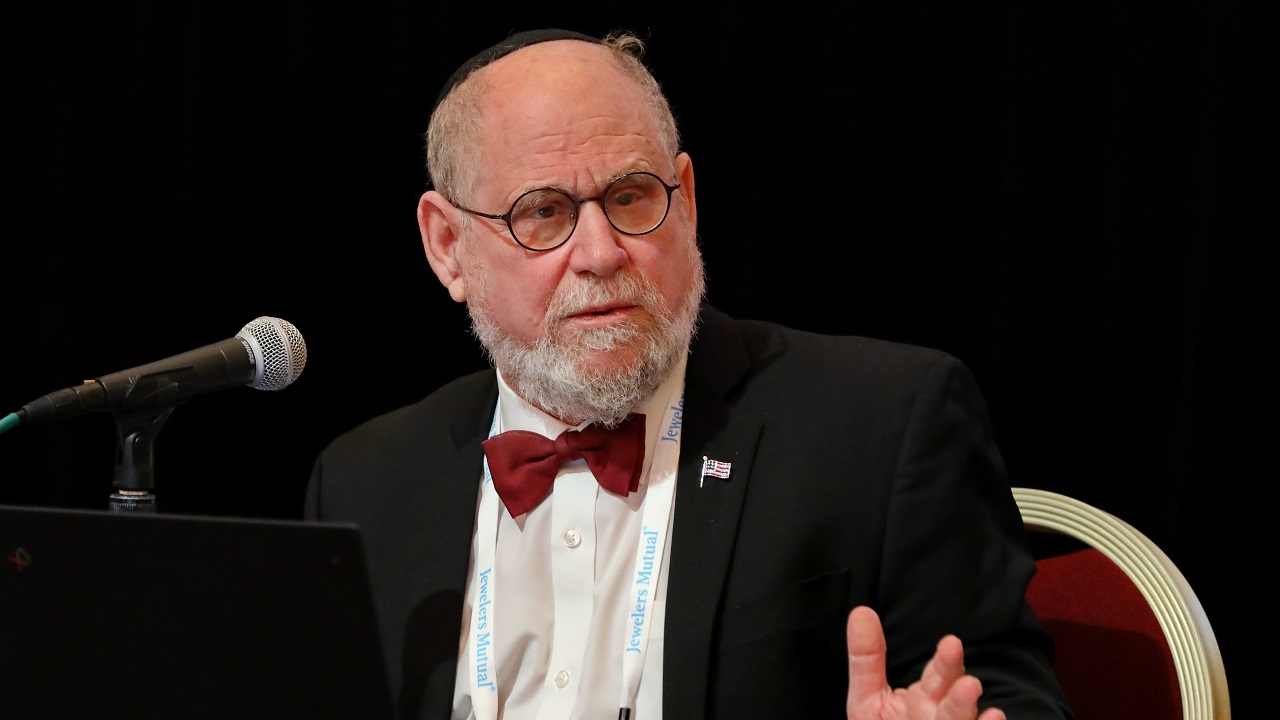Martin Rapaport, chairman of the Rapaport Group, has taken the World Diamond Council (WDC) to task for a proposal it’s advancing to isolate Russian-origin stones from the rest of the diamond supply.
The “G7 Diamond Protocol” was drafted following discussions among the Group of Seven (G7) countries — Canada, France, Germany, Italy, Japan, the United Kingdom and the US, as well as the European Union — to implement additional measures against Russian diamonds, which they claim are funding the war in Ukraine.
The initiative will burden the trade with extensive auditing requirements, whereas it is the job of government to enforce any sanctions program, Rapaport argued in a webinar presentation last week.
“Our job is not to enforce sanctions,” he stressed. “Do not put this on our trade. Customs is the beginning and end of any government sanctions program.”
Government greenwashing
The US government banned the importation of diamonds of “Russian Federation origin” in March 2022, following the outbreak of the war. The word “origin” enabled a loophole that would allow for the import of diamonds sourced from Russian rough, but transformed into polished in other countries, such as India — the largest manufacturing center.
Russian diamonds continue to enter the market. Alrosa — the mining company partly owned by the Russian Federation — saw sales of RUB 188.16 billion ($1.9 billion) during the first half of 2023, in line with the equivalent period last year.
A letter sent to the Office of Foreign Asset Control (OFAC) requesting clarification regarding whether Russia-sourced diamonds, or those that have undergone “substantial transformation” — such as cutting and polishing — in other centers, are allowed into the US, was not answered, Rapaport reported.
It is not in the interest of the government to implement such a ban, as it must consider its relationship with India, a nuclear power that acts as a buffer to a rapidly expanding and aggressive China, he surmised.
“India wants to continue exporting Russian-sourced diamonds to the US, and so we have sanctions that don’t work so as not to upset India,” Rapaport explained. “The US government wants to look good at the expense of the diamond and jewelry industry, so it’s greenwashing, just like the Kimberley Process.”
Rather, the US State Department has joined an initiative among the G7 nations to stop the importation of Russian diamonds to the US, leaving it to the industry — under the banner of the WDC — to monitor and audit the flow of those goods, Rapaport said.
“The protocols are designed to track all diamond transactions from everyone, everywhere on every invoice with extensive auditing requirements,” he explained. “The catastrophe is that the WDC protocols are a death sentence for the small- to medium-size companies in our trade that don’t have the human and financial resources to meet the extensive WDC compliance requirements.”
Inaccurate assertions
A WDC spokesperson responded that Rapaport’s assertions were entirely inaccurate.
“The proposal facilitated by the WDC has been the result of engagement with a wide range of stakeholders across the industry and is designed to be both effective and practical so that it can support the needs of all diamond companies — large or small,” stressed WDC executive director Elodie Daguzan.
Daguzan also dismissed the idea that the protocol was a WDC proposal, clarifying that there was an industry initiative facilitated by the WDC, which was undergoing public consultation. “Any constructive feedback is welcome to enhance the proposal,” she said.
Rapaport’s comments are “a misrepresentation of the proposed protocol, which is designed to segregate non-Russian diamonds starting from rough and maintaining that segregation through to the diamond cutting and polishing process,” Daguzan explained.
Under the protocol, those that choose to participate in the process would employ a declaration on their invoices. Those companies already participating in recognized auditing schemes, such as through the Responsible Jewellery Council (RJC) and others, would be audited as part of their usual schedule, she noted.
Small companies that are part of the formal sector can use their accountant to reconcile carats in and out with the declaration, to support the requirements of smaller diamond businesses, while the protocol also provides a feasible solution for the artisanal mining sector to ensure that “no one is left behind,” Daguzan added.
Power grab
Rapaport cautioned that the protocol would enable the mining sector to control the polished-diamond market through the selective distribution of auditable rough diamonds. This will extend mining market power from rough to polished markets, since smaller companies that do not have access to auditable rough or polished controlled by larger companies will be forced out of the business.
“The proposal not only segments diamonds into auditable and non-auditable, but it also segments people into large and small companies,” he stressed. “It’s a power grab by the big boys.”
Rapaport urged the trade to reject the G7 protocol. He outlined a Rapaport proposal that would require a declarative statement by the importer and overseas supplier stating, “to the best of my knowledge the diamonds being imported do not originate from any US sanctioned entity,” and stressed it would be left to the government to enforce the law. He presented a similar statement for other G7 countries.
In addition, Rapaport urged the industry to hold government responsible for implementing the sanctions and launched a campaign for members of the US trade to lobby their local congressional members to gain clarity on the issue of substantial transformation.
“We need an answer from OFAC so that it is a question of law, not a voluntary program,” he stressed.
Misrepresentation or inclusive?
Turning to the WDC, Rapaport argued that the organization was wrongfully extending its mandate to the polished market, whereas it was established to represent the trade at the Kimberley Process — a body that monitors the cross-border flow of rough diamonds.
With the creation of a protocol that relies on the industry to self-monitor its trade in Russian diamonds, the WDC is extending the reach of the large mining and jewelry retail companies that fund the organization into the polished market., Rapaport said.
“They are cynically using the issue of responsible sourcing to create national laws that require unacceptable compliance requirements that will force small companies out of our trade, reduce competition, and destroy our markets,” he explained. “The WDC wants market power for the big companies that fund them.”
Rapaport said the industry must stop the “misrepresentation” whereby the WDC holds itself out as the sole representative of the diamond trade. “I am calling on members of the diamond trade to officially resign from the WDC and send them notice that they are not to represent them in any way,” he stressed.
The WDC, meanwhile, maintains it has been mandated to drive the G7 initiative forward, and that it is focused on being inclusive of the whole industry.
“The WDC is focused on facilitating an inclusive process with an aim to put forward a comprehensive approach that would not favor one commercial center over another and would do what we are all seeking to achieve — prohibit Russian diamonds from entering G7 countries,” Daguzan said. “The solution facilitated by the WDC is designed to be fair and accessible to all.”
Stay up to date by signing up for our diamond and jewelry industry news and analysis.
Main image: Martin Rapaport. (Rapaport News)



